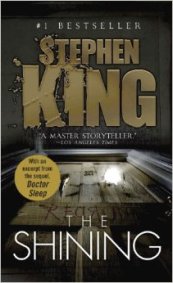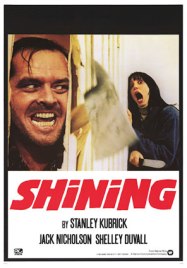
The Shining (1977) and “The Shining” (1980) are probably one of the greatest hallmarks of horror. The novel written by Stephen King and the movie made my Stanley Kubrick have became such recognizable elements of popular culture, especially the scene of the twin girls. The cartoon show “Phineas and Ferb”, with its references to classic movies like “Citizen Kane” or “Star Wars”, has more than once referenced “The Shining”, definitely weird for a children’s cartoon.
There is little doubt that Stephen King is one of the most prominent writers of this time. His many works have been made into movies or TV series, such as Rita Hayworth and the Shawshank Redemption, Carrie, and many many others. My personal favorite of movies based on his writings is “The Mist”, which could possibly be my favorite horror of all times.
Stanley Kubrick is also a name film snobs would most certainly recognize. Director of “2001: A Space Odyssey”, “Lolita”, and “A Clockwork Orange”, his use of visual storytelling has always been fantastic, if not often haunting.
Kubrick is also a name film snobs would most certainly recognize. Director of “2001: A Space Odyssey”, “Lolita”, and “A Clockwork Orange”, his use of visual storytelling has always been fantastic, if not often haunting.
Such a pairing surely seems impeccable, and there is no doubt both the novel and the movie are very well done, but here I am, nitpicking the slight differences between the two incarnations and the effects they have on the reader/audience.
For starters, I must suggest watching the movie before reading the novel. I would suggest this for most movies or shows based on books, perhaps for the exception of the “Lord of the Rings” Trilogy and the “Game of Throne” show. “Harry Potter”, “The Hunger Games”, “The Hobbit”, among others, all have somewhat disappointed me. I like many elements of these movies, no doubt, but I’m certain that my level of enjoyment have been much reduced by setting high expectations by reading the novels beforehand. For “The Shining”, it is no different.
I first bought the book to read last year, and I loved it completely. The movie, on the other hand, while I can definitely enjoy its entertainment value and appreciate the art and magic of film making with which Kubrick treated his work (the movie is such a glorious show of great visual storytelling), I could not get into the story at all. In fact, it took me two viewings just to finish the movie.
The movie is very good, objectively speaking. It’s use of cinematography, the long shots used in many of the scenes, the look of the sets, and it was definitely scary. I like how the ending was done without too much detail into the future life of the mother and child, because cinematically everything was already said and done, objectively speaking and independent from the novel, because in doing so the movie left out my most favorite lines in the book, but I’ll get to that later. Anything bad to say about the movie without comparing it to the novel is what I consider to be overacting from the two adult leads, which to me was borderline comical in certain scenes.
Now, let me be perfectly clear: I understand that movies and books should not be the same, or too similar. A book allows for long dialogues, a longer time to set up the characters and story elements, while a movie is constrained by its time and visual limitations, without the ability to really do much with other senses such as smell, which would be possible in word form. A movie is done through the language of visuals and sound, while a book is done through the language of, well, language. The following complaints are mostly personal, something I would not have had if I have watched the movie before reading the novel.
As I have said before, a movie does not have the luxury of a long long build up, and this is really obvious when compared to the novel. In the novel the father was much better fleshed out as a sympathetic person, hoping to become a better person but slowly consumed by the phantoms of the hotel as well as his own ego. In the movie he just started out as a hateful human being, and that was the moment I had to stop the movie. In movie form this definitely works out better, since as a horror that wasn’t really the thrust of the movie, but this huge difference did take me out of the movie. Another complaint, and this one is more damaging to the movie itself, was the completely needless side story of the chef character, who told the boy about the “shining”, came back, got killed, and didn’t do anything at all. The entire side plot was pointless, while in the novel he survived, saved the mother and child, and helped them settle down eventually. He also had the best lines in the novel: “The world’s a hard place, Danny. It don’t care. It don’t hate you and me, but it don’t love us, either. ” And I think this is really a weak point for the movie.
Having said all that, the visuals of the movie definitely stands out, the effects still hold up, the use of music gives tension, and together they create a scary movie, not in a jump-scare filled way, but psychological and full of tense moments. Story wise, I don’t think it is as good as the novel, but it fulfills what it set out to be. It is a classic movie, not in the sense of “classic” as “Citizen Kane”, perhaps, but the imprints left by the movie on popular culture sure makes it a must see. And for fans of cinema, this is one of the best looking horrors out there.
If you plan to read the book, do so after the movie, you’ll be able to enjoy both a lot better this way.
